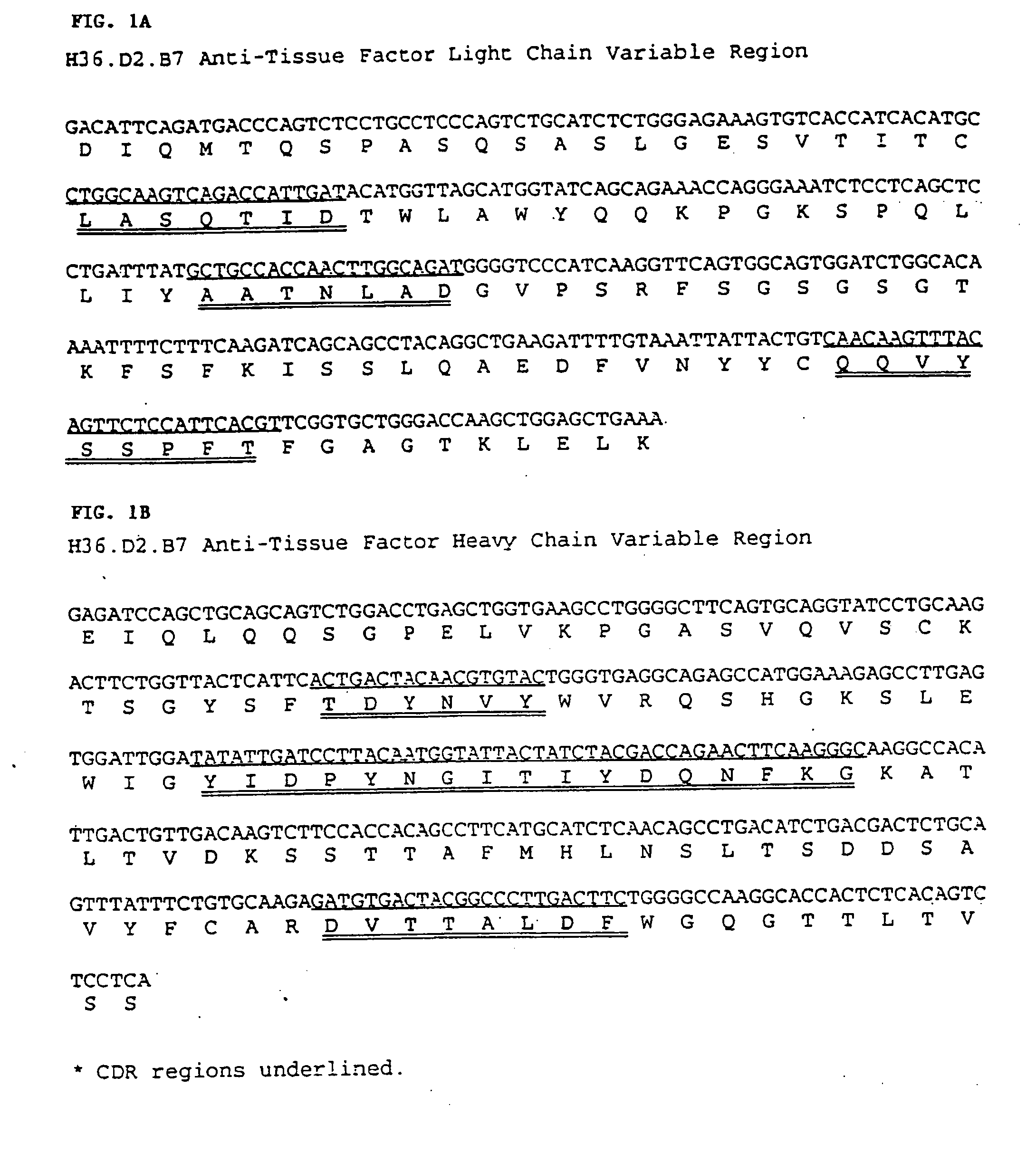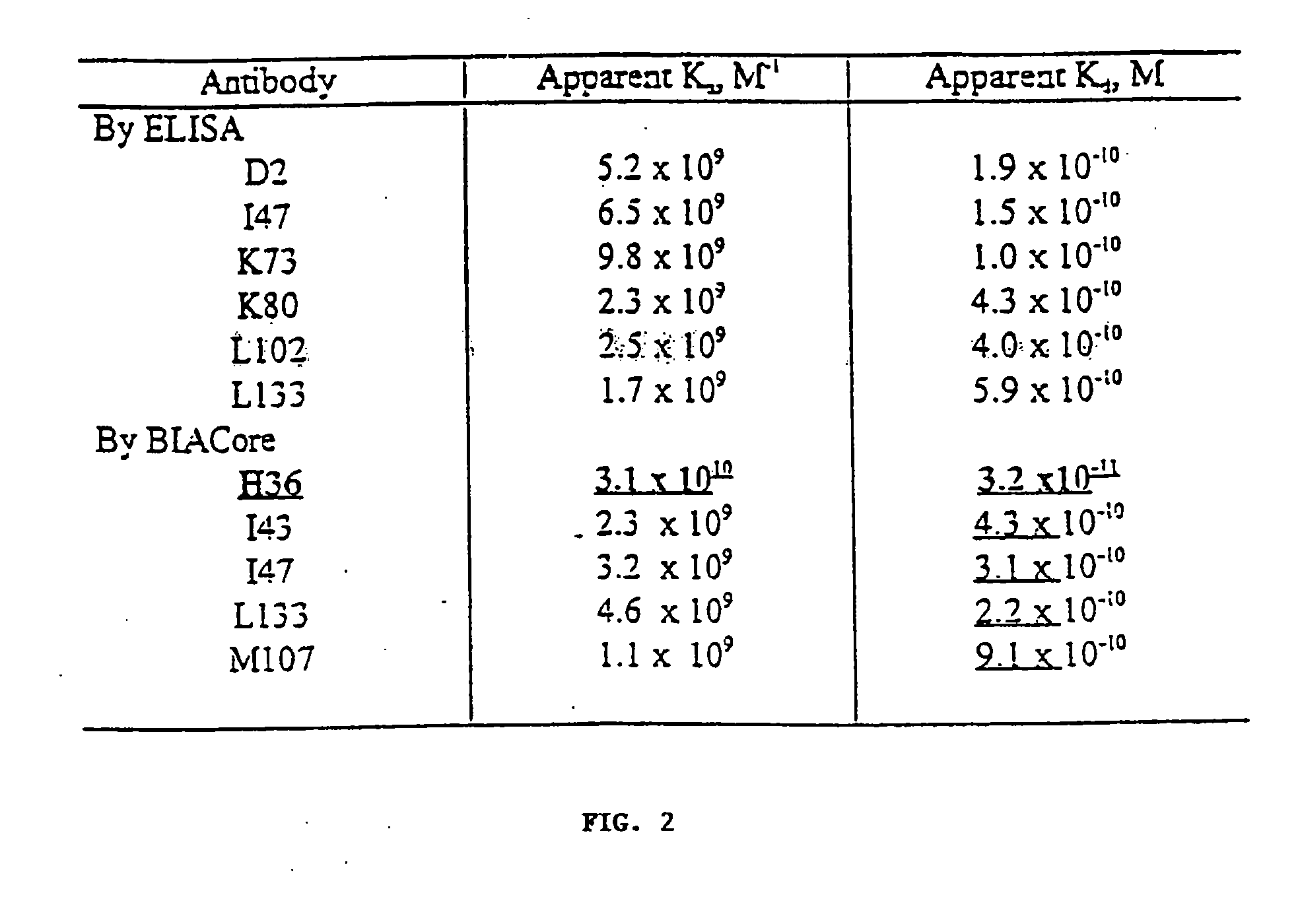Antibodies for inhibiting blood coagulation and methods of use thereof
a technology of anti-coagulation and antibodies, applied in the field of antibodies, can solve the problems of undesirable thrombosis, inability to effectively inhibit blood coagulation, and high affinity of anti-coagulant use, and achieve the effects of superior anti-coagulant activity, effective inhibition of blood coagulation, and high affinity
- Summary
- Abstract
- Description
- Claims
- Application Information
AI Technical Summary
Benefits of technology
Problems solved by technology
Method used
Image
Examples
example 1
Preparation and Cloning of Anti-rhTF Monoclonal Antibodies Monoclonal antibodies against rhTF were Prepared as Follows
[0077]A. Immunization and Boosts
[0078]Five female BALB / c mice were immunized with 10 μg each of lipidated, purified rhTF. The mice were initially sensitized intraperitoneally using Hunter's Titermax adjuvant. Three final boosts were administered in 0.85% NaCl. Boosts were 2, 5.5, and 6.5 months post initial sensitization. All boosts were given intraperitoneally, except the first which was subcutaneous. The final boost was given 3 days pre-fusion and 20 μg was administered.
[0079]B. Fusion of Mouse Spleen Lymphocytes with Mouse Myeloma Cells
[0080]Lymphocytes from the spleen of one rhTF immunized BALB / c mouse was fused to X63-Ag8.653 mouse myeloma cells using PEG 1500. Following exposure to the PEG, the cells were incubated for one hour in heat inactivated fetal bovine serum at 37° C. The fused cells were then resuspended in RPMI 1640 and incubated overnight at 37° C. w...
example 2
Binding Activity of Mabs of the Invention
[0094]Mabs of the invention as prepared in Example 1 above were employed. The rhTF molecule was expressed in E. coli and purified by immunoaffinity chromatography in accordance with standard methods (see Harlow and Lane, supra, Ausubel et al. supra). Mab association (Ka) and dissociation (Kd) constants were determined by ELISA and surface plasmon resonance (i.e., BIACore) assays (see e.g., Harlow and Lane, supra; Ausubel et al. supra; Altschuh et al., Biochem., 31:6298 (1992); and the BIAcore method disclosed by Pharmacia Biosensor). For BIACore assays, rhTF was immobilized on a biosensor chip in accordance with the manufacturer's instructions. Constants for each Mab were determined at four antibody concentrations (0.125 nM, 0.25 nM, 0.5 mM, and 1 nM).
[0095]Protein concentrations were determined by standard assay (M. M. Bradford, Anal. Biochem., 72:248 (1976)) using Bovine Serum Albumin as a standard and a commercially available dye reagent (...
example 3
[0097]In general, the experiments described herein were conducted using rhTF lipidated with phosphatidycholine (0.07 mg / ml) and phosphatidylserine (0.03 mg / ml) at a 70 / 30 w / w ratio in 50 mM Tris-HCl, pH 7.5, 0.1% bovine serum albumin (BSA) for 30 minutes at 37° C. A stock solution of preformed TF:VIIa complex was made by incubating 5 nM of the lipidated rhTF and 5 nM of FVIIa for 30 minutes at 37° C. The TF:VIIa complex was aliquoted and stored at −70° C. until needed. Purified human factors VII, VIIa, and FX were obtained from Enyzme Research Laboratories, Inc. The following buffer was used for all FXa and FVIIa assays: 25 mM Hepes-NaOH, 5 mM CaCl2, 150 mM NaCl, 0.1% BSA, pH 7.5.
[0098]Mabs were screened for capacity to block TF:VIIa-mediated activation of FX to FXa. The FX activation was determined in two discontinuous steps. In the first step (FX activation), FX conversion to FXa was assayed in the presence of Ca+2. In the second step (FXa activity assa...
PUM
| Property | Measurement | Unit |
|---|---|---|
| Fraction | aaaaa | aaaaa |
| Fraction | aaaaa | aaaaa |
Abstract
Description
Claims
Application Information
 Login to View More
Login to View More - R&D
- Intellectual Property
- Life Sciences
- Materials
- Tech Scout
- Unparalleled Data Quality
- Higher Quality Content
- 60% Fewer Hallucinations
Browse by: Latest US Patents, China's latest patents, Technical Efficacy Thesaurus, Application Domain, Technology Topic, Popular Technical Reports.
© 2025 PatSnap. All rights reserved.Legal|Privacy policy|Modern Slavery Act Transparency Statement|Sitemap|About US| Contact US: help@patsnap.com



